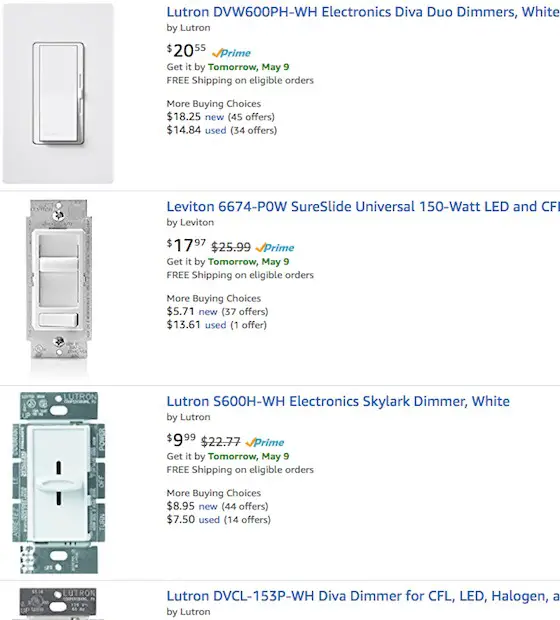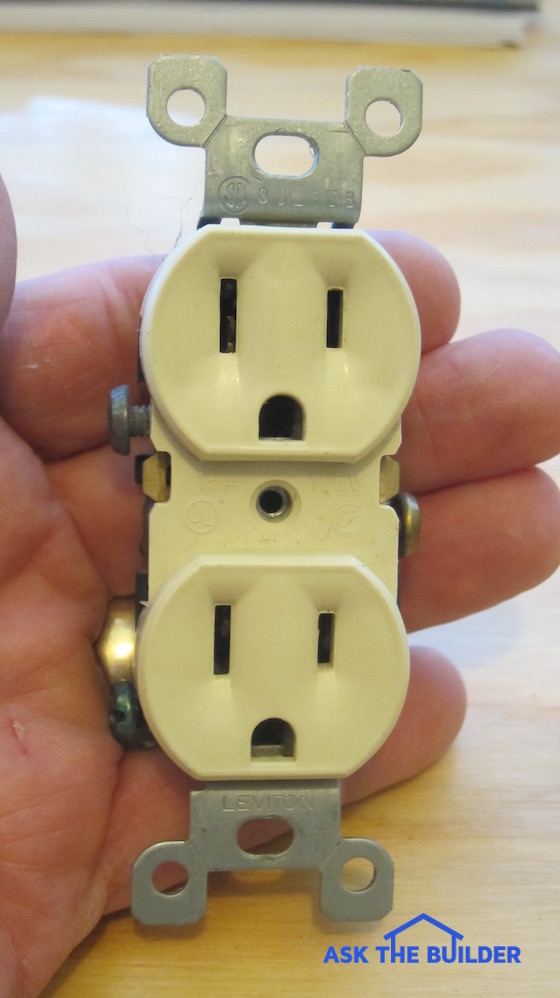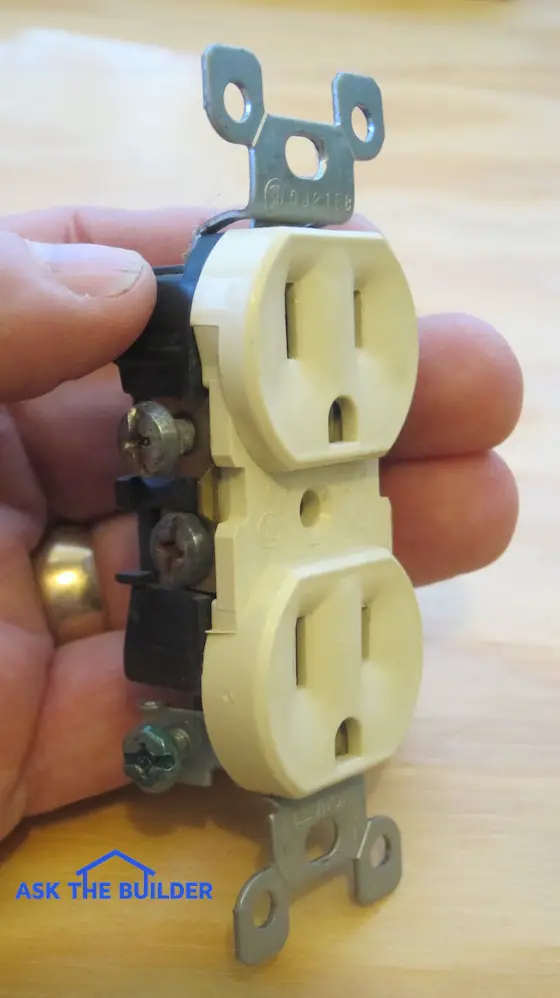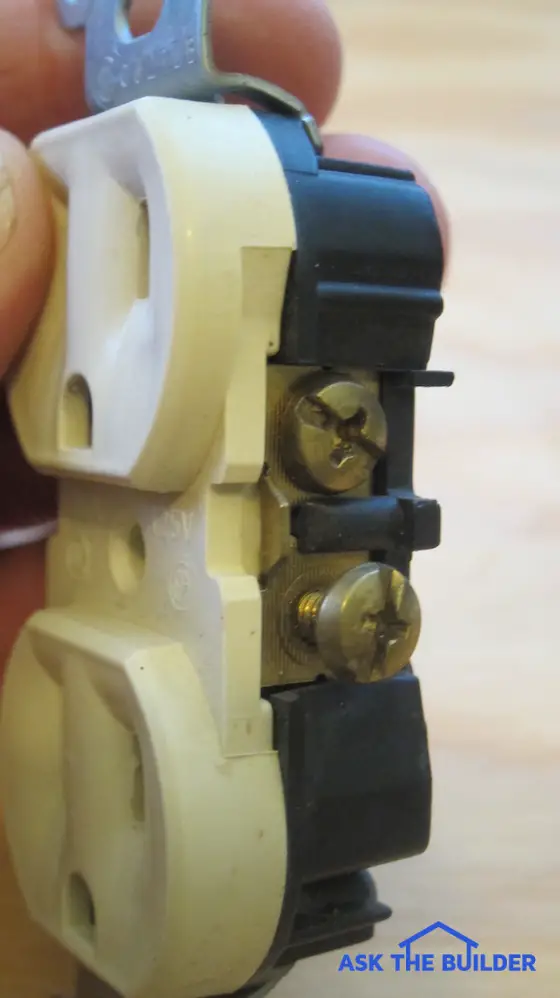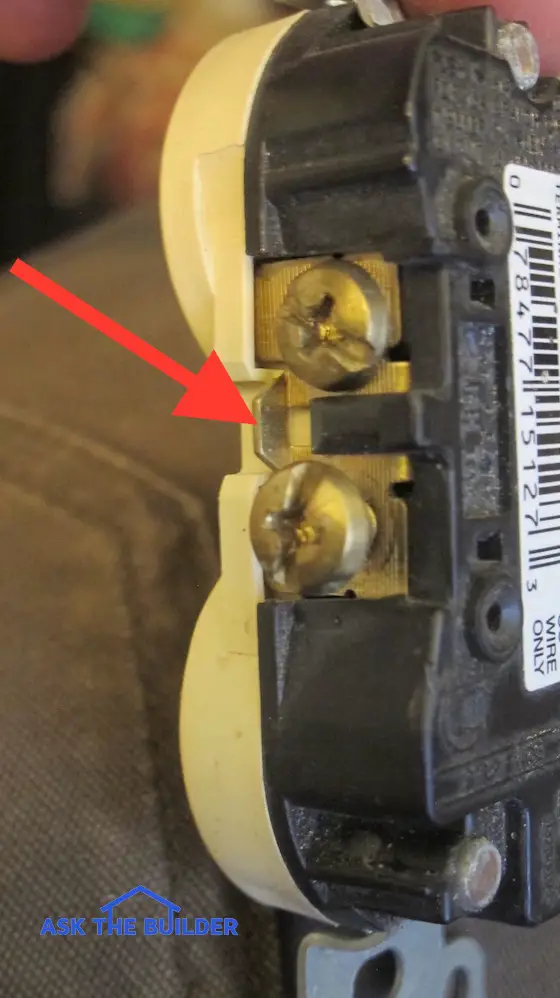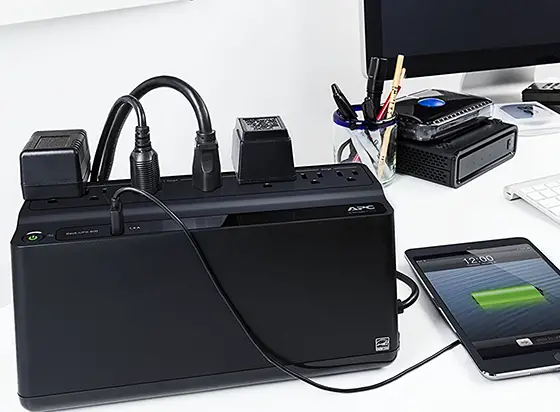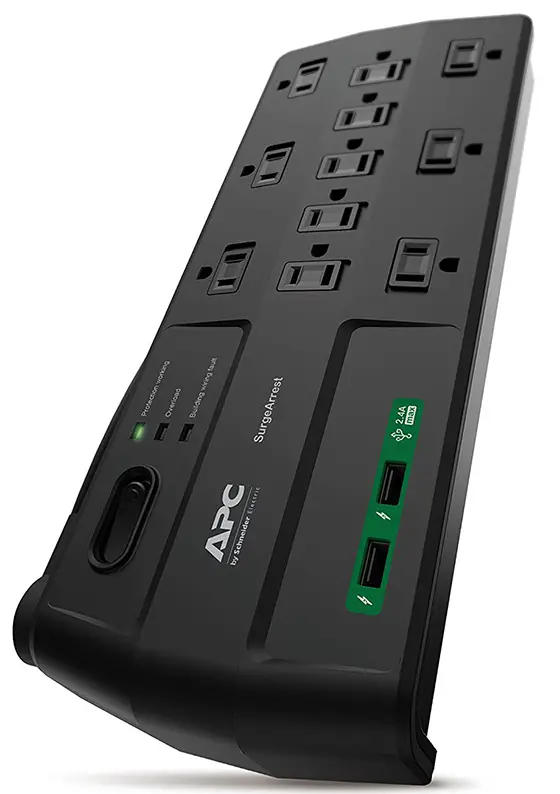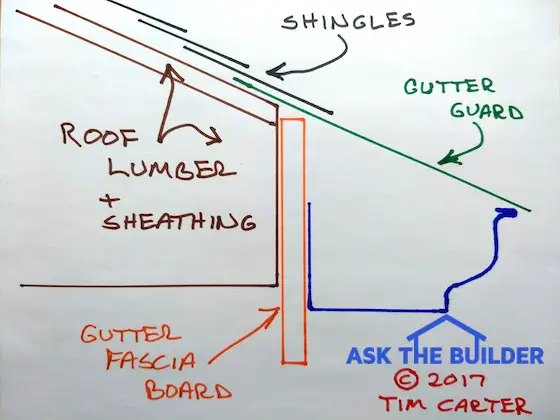
Gutter Guard Truth | Here's a quick cross-section showing how the gutter guard - in green - is in the same plane as the roofing material. The drawing is not to scale. I used to make drawings like this sitting at customers' kitchen tables. CLICK or TAP HERE to purchase an affordable MICROMESH gutter guard I'd put on my house. Copyright 2018 Tim Carter
Important Author’s Note Update: Since this column was written, I've discovered a gutter guard that actually WORKS! It worked so well in my testing that I installed it on my own home.
It's a stainless-steel micro-mesh gutter guard that doesn't allow ANY organic debris into a gutter but allows water to flow into the gutter even in torrential downpours.
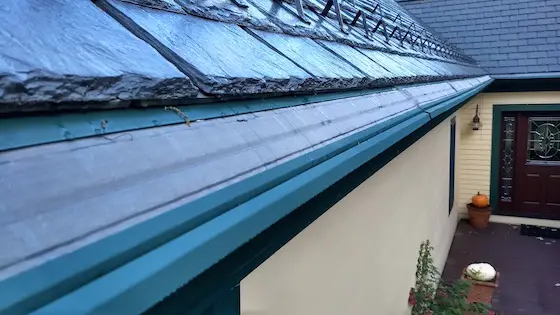
This is the best gutter guard I've ever tested. A stainless-steel micro-mesh prevents any debris from getting into the gutter. You're looking at the front door on my NH home. CLICK on the photo to purchase DIY stainless-steel gutter guards that will save you thousands of dollars. Copyright 2018 Tim Carter
! IMPORTANT - Read Author's Notes at the End of This Column # # # Watch Videos Below!
Dealer-Installed Gutter Guards are Outrageous
Not too long ago, I was talking with a salesman who worked for a gutter guard company on the Eastern seaboard. He was astonished that people actually paid the prices he quoted them.
When he told me he was routinely getting $20 per linear foot for installed gutter guards, I almost fell out of my chair. It's imperative that you sit down and do some calculations before you decide to sign a contract for gutter guards. Some people have paid as much as $30 a linear foot.
DO NOT PAY THESE INSANE PRICES. Purchase gutter guards from Amazon.com and have a local handyman install them. CLICK HERE to order.
Free & Fast Bids
CLICK HERE for FREE & FAST BIDS from local companies that can install micro-mesh gutter guards.
Consider purchasing a micro-mesh product from Amazon.com and having your local handyman install them for you. CLICK the photo below for just one of the micro-mesh products I discovered on Amazon:
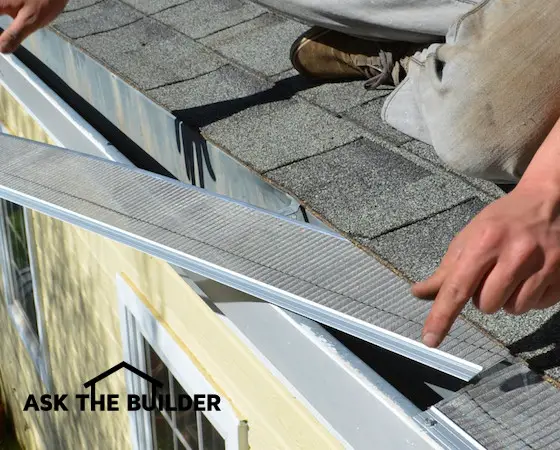
There are many micromesh gutter guard products. You can save LOTS of money putting them on yourself. CLICK ON THE IMAGE to see how low-cost they can be.
DEAR TIM: Every fall, I get deluged with both leaves in my gutters and advertisements from companies selling gutter guard products that promise me I will never have to clean my gutters again.
The few estimates I have requested have taken my breath away because of the high price. First, do these products fulfill their claims?
If not, why? Is one better than the other? What is the most cost-effective way to keep my gutters free of leaves and debris? Stephanie W., Cranberry, PA
DEAR STEPHANIE: I'm not surprised at all by your comments but wonder why you only mentioned half of your problem.
Spring Is The Biggest Gutter Problem
If you have deciduous trees, that drop leaves onto your home, then you undoubtedly suffer in the spring as well as the fall.
All deciduous trees produce organic litter in the form of buds, flowers, seeds, small bits of bark, twigs and leaves on a never-ending annual cycle until they die and then fall over. Evergreen trees are just as guilty as they shed needles and other bits of debris throughout the year.
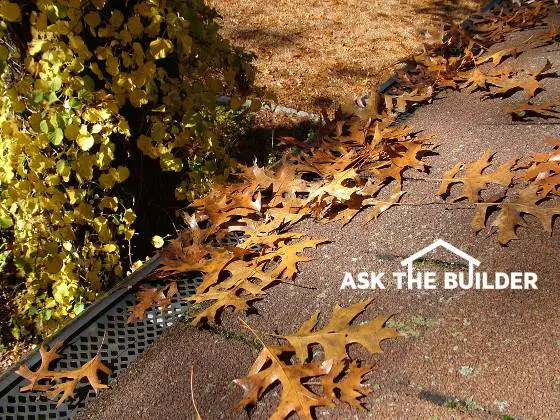
This simple gutter guard is working well now but wait until spring. Those knock-out holes you see will be clogged with twigs, flowers, bark, seeds, flower buds, etc.
Stratospheric Prices
The prices you speak of for these gutter guard systems not only take my breath away, but they knock me back on my heels. I'm convinced the pricing is based solely on emotion.
The companies that sell these products play upon the frustration the average homeowner experiences when faced with the periodic cleaning one has to do several times a year to keep gutters clean.
It's not uncommon for a homeowner to get a price of $2,000 to $3,000 to install gutter guards on the average home. The pricing varies from region to region, and the type of system being installed.
There are do-it-yourself products you can get that will cost less than $200 for the average house so you can see there is a vast array of choices.
Free & Fast Bids
CLICK HERE for FREE & FAST BIDS from local companies that can install micromesh gutter guards.
Consider purchasing a micro-mesh product from Amazon.com and having your local handyman install them for you. CLICK the photo below for just one of the micro-mesh products I discovered on Amazon:

There are many micromesh gutter guard products. You can save LOTS of money putting them on yourself. CLICK ON THE IMAGE to see how low-cost they can be.
Related Links
Payback Period for Guards - How Fast?
Actual Cost of the Guards
To put the final retail price in perspective as to how high it is, you just need to look at the manufacturing cost. Doing some research I've come to the conclusion that the price ranges from ten or twenty cents per linear foot up to two dollars for the most complex micro-mesh guard. These are 2017 prices, so adjust for inflation.
Invest Your Money? Maybe!
But for the moment, let's consider the system installed by a professional roofing company. For the sake of discussion, I'd like to assume an installed price of $2,500.00.
I'd also like to assume that you could invest this same money in a conservative stock that might go up in value just 7 percent per year. If you let the stock just grow in price, at the end of ten years its value would be nearly double having risen in value to $4,917.82. This means you still have your original money plus a gain of $2,417.82.
Annual Cost to Clean Gutters
If you paid a roofing company or handyman just $125 per visit to clean your existing gutters three times per year, you would have paid out $3,750.00 over the same time period. Granted, you need to factor in inflation as the price of the labor will undoubtedly rise.
But you don't need a Ph.D. in Mathematics to see that at the end of ten years you'll have clean gutters and over $1,100 still in your account if you simply pay a roofer to periodically clean your gutters.
Maybe it's a better idea to not put on gutter guards, especially if you plan to move within five years.
Almost All Gutter Products #FAIL
The real truth is that all of the gutter guard products I have tested for years at my own home fail in one way or the other. As soon as new designs become available, the manufacturers tend to discover me and ask me to test the new products.
All gutter guards do stop large leaves from entering gutters, but most of the designs allow small organic debris to enter the gutter system or this debris clogs the gutter guards causing water to cascade off the roof!
Gutter Guard Videos
Watch all these gutter guard videos of mine. You'll see WHY most fail and you'll see the one I put on my own home!
Layer Of Muck And Goo
If this organic debris that does enter the gutter is not cleaned out on a regular basis, you end up with a layer of goo and muck in your gutters.
If you must install gutter guards, then absolutely make sure you buy ones that allow you to easily see through them to the bottom of the entire gutter.
Avoid Solid-Topped Guards
Avoid gutter guards that have solid tops and small slits near the front edge. Look for gutter guards that have a larger mesh-type open structure that resembles a fishnet or even a chainlink fence. These systems allow you to aim a garden hose nozzle through the guard so that water can easily flush away the organic goo that will collect in the gutter. Remember, you'll have to clean your gutters or the gutter guards themselves UNLESS YOU GET A GUTTER GUARD THAT STOPS ALL DEBRIS BUT ALLOWS WATER INTO THE GUTTER.
I've tested no less than twenty different gutter guard products over the past eight years. Each year, I get to look at ones that offer new hope or more of the same.
Some of the gutter guards get horribly fouled with the spring-time debris that falls from the trees onto my roof. My pin oak trees create flower blossoms that resemble miniature lace. This mass of organic debris has terrorized each and every gutter guard. When my maple tree is not hit with a spring frost that kills the flower buds, the gutter guards are clogged within days with hundreds of thousands of maple seed helicopters.
Half-Truths By Salespeople
Beware of salesmen who tell you all of the organic debris is washed away by rain or blown away by the wind. It's not true if the organic debris can get trapped in the openings of the gutter guard.
Home & Garden Show Test
You can test it yourself the next time you visit a home and garden show that has a small gutter guard setup with water cascading down a little roof, across the guard and into a gutter. Tear off a small piece of paper about the size of a postage stamp or your thumbnail and drop it onto the running water. I guarantee that it will be carried into the gutter or it will clog the guard. It will not fall onto the floor of the convention center.
In need of gutters? Pick out the right ones with my Gutter & Downspout Installation / Repair Checklist. I offer a 100% Money Back Guarantee.
Author's Notes -
As you might imagine, columns written as the one above have the potential to ignite a firestorm of controversy. Manufacturers of gutter guard products that do fail and the distributors who sell them are immediately cast in a deep shadow of doubt.
But imagine how I felt when I received the following email from Ms. Ann Pattison on November 7, 2004 the day the above column ran in The Toledo Blade:
"Hello, Tim,
My name is Ann Pattison, I am the proud owner of A -1 Gutter Cleaning based in Toledo, Ohio. I am writing to you regarding your article in The Toledo Blade that appeared on November 7, 2004, about gutter guards. I absolutely agree with your article.
For years I have been telling customers the same things you mentioned in your article. It is the truth. I have been in business for 15 years and have been cleaning gutters for 20. I will install a screening if a customer really wants some type of cover. However, I also still go out yearly to maintain this screening. Each year I have to clean off the screen I installed and then I must flush out the gutters.
I also take a lot of screening off because it was never maintained properly. If you install a cover, you cannot find a clog unless you take everything off. This is very time-consuming. There is lots of labor involved. Gutter guards that allow you to see the bottom of the gutters do work best just as you say. But if you use a cheap roll out screening, it will be pushed right into the gutter as soon as leaves fall on it. So you must check out the material you are having installed. That also makes a big difference.
I just wanted to write you and thank you for your article. You are absolutely right on everything you said especially on the pricing. It is ridiculous. I do install a good screening cover that is a very thick gauge and works very well with proper maintenance for less than $3.00 a foot. If I can be of any service to you, please let me know. You can reach me at 419-865-1941 or 888-888-0842.
Ms. Ann M. Pattison A-1 GUTTER CLEANING"
Several days later, I received a letter from a homeowner who lives in Bensalem, PA with comments of his own. Thanks Louis! You really proved my point.
November 11, 2004
"Dear Mr. Carter:
Thank you - Thank you - Thank you. Your article on Guarded Gutters hit the nail on the head. Every time I see a full page ad in The Courier-Times or other papers or on TV I get so angry. The guys who installed my gutters were called "Gutter Solutions." They came out once to clean the gutters, then when they clogged up again I called them back. They said the guy who signed my contract no longer worked there. I was out of luck.
I paid a lot for these gutters - so-called Clog-Free. What a joke! Sure, big leaves don't get in, but the other stuff which is even worse than leaves really clogs things up. My gutters overflow during a heavy rain like Niagara Falls.
If a gutter company says they will come out and clean your gutters for free if they clog. . . Get it in writing!!! Their bill even said: Guaranteed not to clog. It's a bunch of baloney.
Years ago I had seamless gutters installed. They added 3-foot screen covers, and they put them on upside down. Yes, Mr. Carter. Upside down. It took lots of phone calls to get them to come back out and fix things.
Thanks for listening to me, Mr. Carter.
Yours truly,
Louis Cesarone, Jr. (Senior Citizen)"
Tim,
I've read your article about gutter covers and agree completely. Yesterday, I spent 2 hours cleaning out this foul muck in the bottom of my gutters that had clogged them up. I ripped off my gutter covers and threw them in the trash.
While looking for solutions to my being lazy and not wanting to clean out my gutters EVER again, I came across _ _ _ _ _ . (Named Removed by Tim Carter to Protect the Guilty) Have you tried these? Do they work or am I just hoping that I never have to be covered with muck and mosquito bites again anytime soon.
Thanks!
Amiee Staggs
Bloomington, IN
This email just arrived today, August 29, 2005.
Loved your discussion of gutter guards. I bought into the "never clean" line and purchased a system that had a solid cover over the gutter. Clogged up within 6 months! The company did come out and clean them, but after we had a major overflow and basement flooding. The company knows its product is not clog free -- they even had the gall to give me a special hose adapter so I could flush out their "clog free" gutters.
Eileen G.
Upstate NY
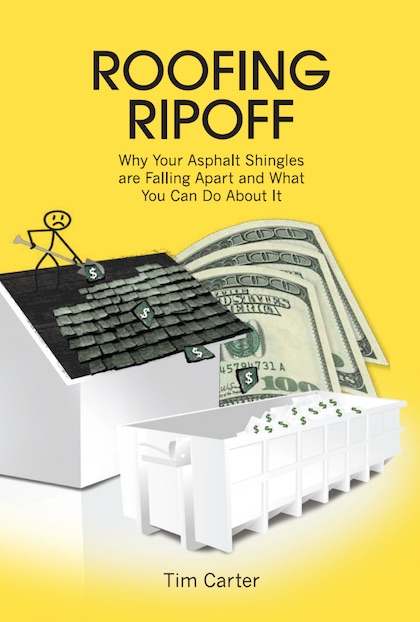

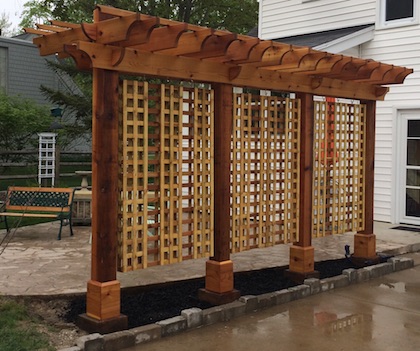
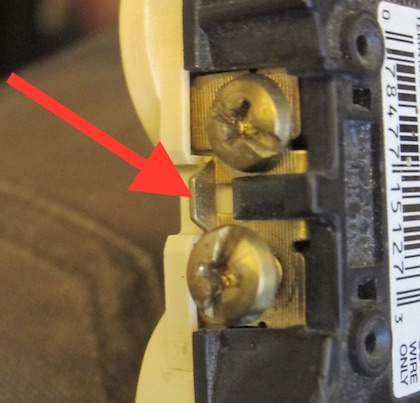
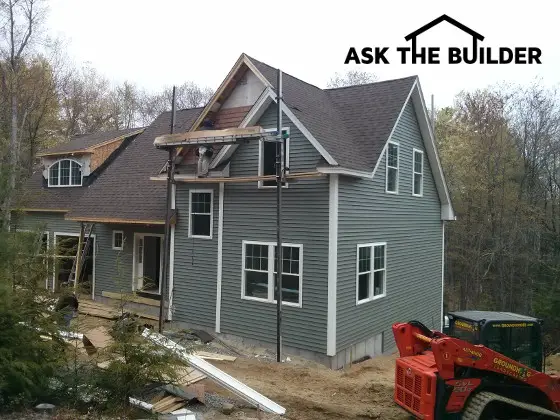
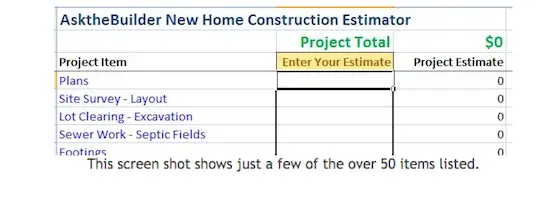
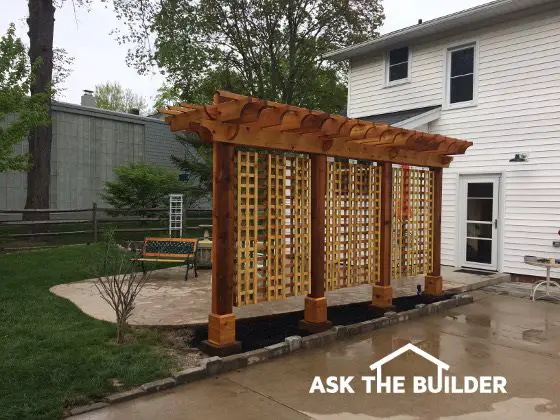
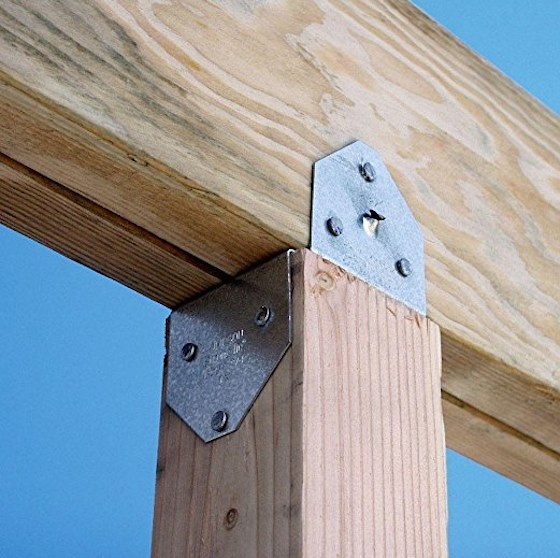
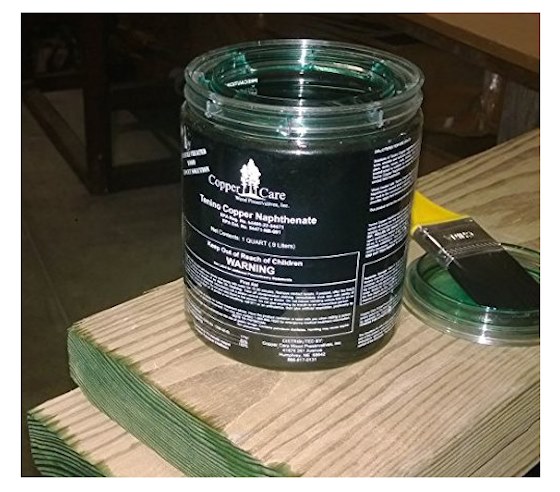
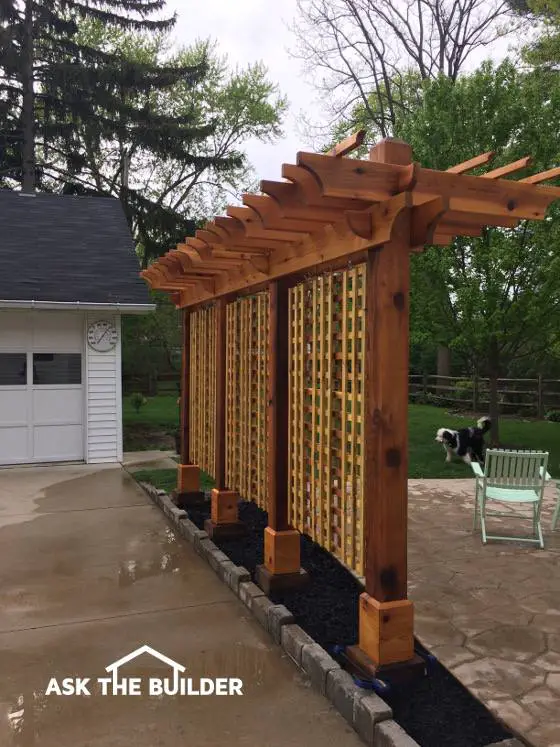
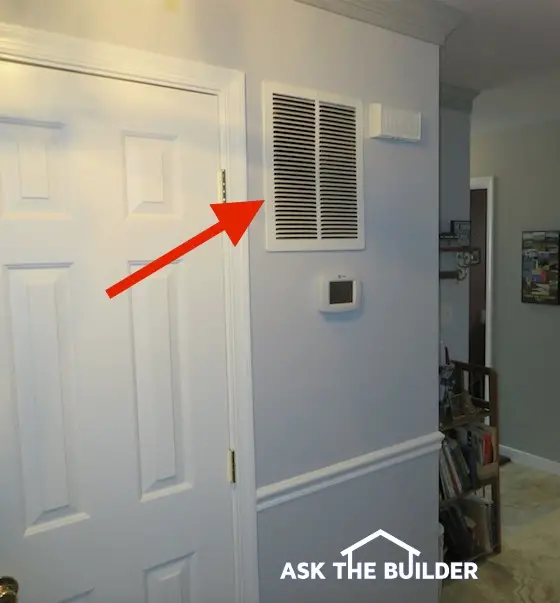

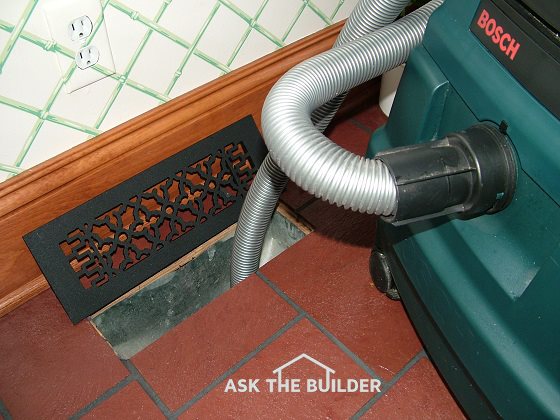
 The reason dimmer switches get hot is fairly simple. Some dimmers get hotter than others because of their design.
The reason dimmer switches get hot is fairly simple. Some dimmers get hotter than others because of their design.